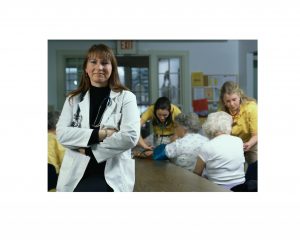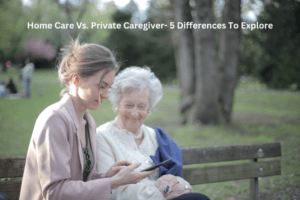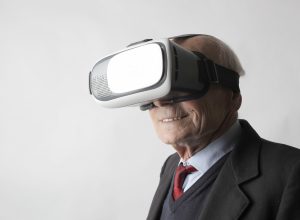Dr. Mauk’s Boomer Blog
Each week, Dr. Kristen Mauk shares thoughts relevant to Baby Boomers that are aimed to educate and amuse.
Dr. Kristen L. Mauk, PhD, DNP, RN, CRRN, GCNS-BC, GNP-BC, FAAN

Guest Blog: Home Care Vs. Private Caregiver- 5 Differences To Explore
Introduction
Back in the day, the concept of the elderly needing care was majorly related to caregiving by the family or kids. Some fortunate parents got the best care from their family, while the unlucky ones had to suffer misery, depression, and prevailing sad moods, which eventually impacted their health. It is not always the family negligence, but sometimes the situation is so challenging that the elderly themselves have to let go of their families so that the next generation does not miss out on any opportunity to improve their lives.
Some compassionate people understood the need for every senior citizen to have good company, a clean environment, food, and medicine to spend the most crucial phase of their lives in harmony. The concept of senior home care was introduced, where the elderly are provided child-like care to keep them away from any adverse event or energy.
In certain places, there are purposefully constructed home care centers carrying every necessity and plan for a peaceful life for the elderly. On the other hand, we have private caregivers who care for the elderly. People often need clarification on the two types and find it challenging to decide which suits them.
What is Private Caregiver?
Private caregivers are hired and employed directly by senior citizens or their close family. Apart from providing help to senior citizens with ADLs or IADLs, some private caregivers are also trained to provide some medical care such as wound care, injections, and monitoring vital signs. However, this is rare and would cost more at a higher hourly rate.
What is Home Care?
Home care agencies are licensed businesses that hire a team of caregivers. The agency then contracts with families to send caregivers to their loved one’s homes to provide the necessary long-term care services. Some agency-based caregivers may be certified nurses or nursing assistants who can offer medical care. Some others provide legal assistance with ADLs or IADLs.
5 Differences between Home Care and Private Caregiver
- Cost Difference
Private caregivers offer services at an affordable rate. They are averaging around $15 per hour—which can be between 20 and 30 percent lower than caregivers hired via an intermediary home care agency. On the other hand, While costs can vary significantly from place to place, home care agencies are more expensive than independent caregivers across the board. Nationally, the average hourly rate for home care through a home care agency is $20+ per hour—approximately 20 to 30 percent more than an independent caregiver.
- Certification
The home care service centers are registered with the government, and there are regular inspection raids to ensure the quality of services. The strict check also provides that the caregivers are well-trained and certified; they even have to attend regular workshops to improve their skills.
An individual hires private caregivers, so quality assurance or checks must be made by the individual, which could be more satisfactory due to the lack of resources. The certification checking services are also not available to ordinary people, so you cannot guess whether a person has a valid, accurate degree.
- Family Involvement
No matter how excellent care you get from any outsider, no one can match the happiness one brings from the love, respect, and attention received from family members. They say blood relations never fade away, which is the world’s reality.
Everyone craves love from their loved ones. In the case of in-home care service centers, family involvement is minimal as the senior citizens have to stay within some building or boundary. However, the private caregivers attend to the senior citizens in their own homes so the family can also pay attention to their elderly and keep a check on the private caregivers.
- Facilities Available
In-home care services are packed with facilities necessary for the well-being of senior citizens.
The available equipment, medicines, and other necessities are provided to the elderly in need within seconds.
On the other hand, in private caregiving, the employers have to take care of the necessities themselves, meaning they have to wander in the market to get medicines and medical equipment.
- Availability
Since the in-home care centers are buildings based, they have a minimum or maximum capacity, so they may get overcrowded or run out of space. In the case of private caregivers, if you hire them full-time, they can focus on an individual elderly’s care without any competition among themselves.
Guest Blog: 4 Ways You Can Find Affordable Homecare
Home care is often preferred by seniors. An overwhelming 90% of seniors want to age in place. It is also affordable compared to nursing homes and assisted living facilities. However, hiring a caregiver may still be out of reach for many families.
1. Home Care Agency
A popular option for hiring a caregiver is through a home care agency. Hiring a caregiver through an agency allows seniors to have personalized one-on-one attention and flexible pricing (choosing less hours means saving on costs). You are also not responsible for any employer obligations like payroll tax and being held liable for any injuries that happen at home. However, this means that agencies pass administrative costs to the family which may still be unaffordable.
2. Family Caregivers
Did you know that there are an estimated 40 million unpaid family caregivers in the United States? Family caregivers perform a wide range of duties like paying bills, running errands, and helping with light household chores. Many family caregivers dedicate on average 20 hours a week towards providing care and some take time off work as well—resulting in a loss of earnable income. While being a family caregiver can save you money, your loved one may have needs that go beyond what you can support.
3. Local Classifieds
You can hire a caregiver directly through your local classifieds or online directory. Hiring a caregiver directly, and not through an agency can provide more affordable home care for your loved one, but there are some extra hurdles. You will need to personally interview and screen potential candidates. This involves meeting with the caregiver, verifying their references, and performing a background check. If your loved one needs care immediately, this process may be difficult and time consuming to do properly.
4. eCaregivers
After learning about using eCaregivers, you can find private caregivers with rates starting at $10-$14/hour for care, versus $20-$24 with an agency, helping you save thousands of dollars in a year while still ensuring quality home care for your loved one. All of the caregivers on eCaregivers have passed a background check so you have a peace of mind that you’re hiring a vetted caregiver for your loved one.
About the Author
Peter Kang is a writer for eCaregivers. He is inspired by his caregiver experience with his late grandfather and role model, a Korean War veteran, to help families find affordable care for their loved ones. Follow Peter on Facebook and Twitter.
Guest Blog: Addressing Senior Malnutrition
When it comes to consuming sufficient amounts of vitamins and minerals, turns out many seniors aren’t. Chronic disease, dietary restrictions, limited income and access to food, reduced social contact, and other factors can increase a senior’s risk for malnutrition. There are simple solutions however for addressing the problem – don’t miss this quick guide:
Should Seniors Take a Multivitamin?
While the research on the need for multivitamins in the average American adult’s diet goes back and forth, when it comes to senior health specifically, experts can agree on some things. With older age often comes diminished appetites, decreased digestive functioning (which can affect nutrient absorption), as well as less energy, bone loss, and reduced muscle mass.
While seniors should invest in core diet staples like fresh fruits and vegetables, whole grains, nuts, legumes, and lean proteins, they may also want to talk to their doctor about nutritional supplements like multivitamins.
Multivitamins for older adults can vary. Some multivitamins with added calcium and vitamin D are ideal for active women over 50, for example, while others may come with herbal ingredients that offer memory or energy improvement.
Easy Ways to Boost Nutrient Intake
While it might seem like nutrition shakes are the simplest solution for undernourished seniors, there are also fairly simple ways to incorporate more whole foods into a daily diet.
A high-powered blender is the ultimate nutritional tool a senior has at their disposal. These hi-tech devices process food at super speeds, helping to easily blend even the toughest ingredients like nuts and seeds. They are especially handy if you are a senior who struggles with dysphagia, the inability to safely swallow foods.
- High-power blenders allow you to mix loads of healthy ingredients like fresh fruits, veggies, beans, greek yogurt, nut butters and more into smoothies, shakes, soups, stews, and dips. This simplifies the process of putting a meal together and is a much healthier alternative to processed, packaged and frozen meals.
- Recruiting help from a care network can also help boost a senior’s nutritional intake, ensuring regular round-the-clock meals that offer variety in addition to nutrients. Free, online tools like CaringBridge.com and TakethemAMeal.com allow family caregivers, neighbors, or simply friends to coordinate a digital calendar where people can sign up to help a senior with meals.
- Local nonprofit services may be an alternative as well if a substantial care network is not in place. Meals on Wheels, for example, has chapters nationwide that deliver daily meals to seniors in need, and free senior transportation services are available in many regions and can help seniors get to the store to buy groceries or pick up food.
Guest Blog: The Future of Rehabilitation: Trends and Predictions
The Future of Rehabilitation: Trends and Predictions
The field of rehabilitation is evolving rapidly. New technologies are bringing about changes in how we practice and treat patients, and there are many ways OTs can be at the forefront of this shift. Here are predictions for what will change in the future of rehabilitation:
The growth of tele rehabilitation
Tele rehabilitation is an increasingly popular method of treating patients who have experienced a traumatic brain injury or stroke. It allows you to work with a therapist from home and can improve your quality of life while reducing costs for the healthcare system overall.
The expanding role of the occupational therapist
As rehabilitation expands, the role of the occupational therapist is also expanding. OTs are becoming more involved in the healthcare system, working with patients who have a variety of conditions and using technology to help them recover from injuries. Even skin specialists are also part of rehab as they give treatment to patients with chronic skin diseases.
As this information becomes more widely available, more people will become aware that they can benefit from occupational therapy services. As a result, we expect demand for occupational therapists to rise significantly over time–especially as baby boomers age and need assistance with daily activities such as cooking or bathing themselves.
The future of homecare
The future of homecare is a topic that has been discussed at length by occupational therapists. While there are many ways to approach this question, one thing is clear: homecare will continue to be an important part of rehabilitation and recovery processes for patients. They can be taken good care from the comfort of their homes by providing medicines, supplements on time and helping them with their recovery process.
Homecare is often characterized by its flexibility and accessibility for patients who need assistance with daily tasks but do not require hospitalization or other intensive treatment options. For example, homehealth services can provide medical equipment such as wheelchairs or mobility aids; occupational therapy services may include help with physical therapy exercises (such as stretching) or assistive technology devices like iPads for communication purposes; speech-language pathology services might include speech therapy exercises for those who have difficulty speaking due to injury or illness; social work services might offer support groups where people go through similar experiences together so they don’t feel alone in their struggles; etcetera! This combination of different types of care allows patients to maintain independence while being cared for by professionals who understand exactly how challenging day-to-day life can be after an injury or illness has affected someone’s ability
How technology will change the way we practice
The future of rehabilitation will be much more efficient and effective, thanks to technology. We’ll be able to diagnose and treat patients remotely, providing them with support whenever they need it. We’ll also be able to collect data on patient outcomes in order to provide better care in the future.
The use of technology to connect patients with their healthcare providers will increase.
As technology continues to advance and become more accessible, it’s likely that patients will have more opportunities to connect with their health care providers. This can help reduce the need for in-person visits, which can be costly for both insurers and patients alike.
The use of technology will also allow patients to receive instructions for exercises and diet plans remotely–which could save money by reducing the need for physical therapy visits or trips to the doctor’s office.
Telemedicine will become more popular, as well as mobile apps.
The use of telemedicine and mobile apps is growing rapidly, especially among people with disabilities.
Telemedicine is a way to get medical care remotely. Mobile apps can be used in the same way as telemedicine, but they’re also useful for things like monitoring your health data or getting reminders about your next appointment (among other things).
Both methods are growing in popularity because they give patients access to specialists who wouldn’t otherwise be available locally; this includes people living in rural areas without access to nearby hospitals or clinics.
Research on muscle stimulation and brain activity will advance.
As more research is conducted on the brain and how it works, new treatments will emerge. The same goes for muscle stimulation, which is a popular treatment option for stroke victims. Research on both has already led to new methods of rehabilitation; combining these two fields of study could lead us even further into the future of rehabilitation.
VR will be integrated into rehabilitation techniques.
Virtual reality (VR) is a great way to motivate patients and help them visualize their recovery. It can also be used to simulate real-world situations, such as walking through the grocery store or navigating crowded sidewalks.
With advancements in technology, VR will become even more immersive and interactive than it already is today. For example, if you’re recovering from surgery on your hip or knee joint and want to see what it would look like when healed properly, a virtual reality simulation could provide an accurate depiction of what that might look like–and show how much better life could be after rehabilitation!
Data analytics will help identify which patients are responding best to a particular treatment plan.
Data analytics will help identify which patients are responding best to a particular treatment plan.
By tracking data from individual patients, doctors can better understand how each person responds to certain medications or therapies, as well as their overall health status. This information is invaluable for improving patient care and ensuring that everyone gets the best possible treatment options based on their specific needs. For example, if you have diabetes and you’re taking medication to manage it, your doctor may want to monitor how much sugar is in your blood at different times throughout the day (or night). If this number creeps up too high or too low without any apparent reason–for example, if you’ve forgotten about taking your pill–the doctor can adjust dosage accordingly so it doesn’t happen again.
An increasing number of people who have been in car accidents or had strokes will seek online support groups from others who have experienced similar injuries.
As more people are able to connect with others who have been through similar experiences, they will be able to find support groups online.
Support groups provide a great way to talk about your feelings and learn from other people who have experienced the same injuries as you. For example, if you were in an accident or had a stroke, you could join an online support group where people who have been through those things can share their stories with each other. It’s easier for most people to open up about personal issues online rather than face-to-face because there’s no pressure or judgment involved when communicating via social media platforms like Facebook Messenger or Reddit threads (or even text messages).
These trends hold great promise for people who need physical therapy and other types of rehabilitation
As technology becomes more and more integral to our lives, it’s no surprise that it will affect the way we practice rehabilitation. Here are some of the most significant trends:
- More patients will be able to connect with their healthcare providers via video chat and other forms of telemedicine. This means that you can meet with your physical therapist or other health professional in person less often, which saves both time and money for both parties involved.
- Mobile apps that make therapy easier to access may become more popular among patients looking for alternatives to traditional treatment options like physical therapy or occupational therapy (OT). These apps allow users to track their progress at home or on-the-go by inputting data into their phones’ sensors–which could lead those who need rehab services but don’t have time for regular appointments with professionals like us here at Fitness & Wellness Center!
Rehab is evolving, and there are lots of opportunities for OTs to be at the forefront.
OTs will be in a good position to help patients get back to their day-to-day lives.
The future of rehabilitation is evolving, and there are lots of opportunities for OTs to be at the forefront. You can help patients recover from injuries or illnesses by helping them get back into their daily routines–whether that’s working out, cooking dinner or just sitting down on the couch with their family after work. This can also include helping them set up home gym equipment or find ways around obstacles if they’re having trouble walking up stairs.
Conclusion
We can’t predict the future, but we can prepare for it. If you’re an OT or PT who’s interested in working with technology, I encourage you to explore these areas and see how they might apply to your practice. You may not be able to use every one of these technologies right away–after all, not everyone has access to VR equipment or telemedicine programs–but they are important tools that can help people recover faster from injuries and illnesses.
Guest Blog: Tips for Caregivers Helping Seniors with Anxiety
Taking care of seniors with anxiety requires special attention and understanding. As a caregiver, providing the necessary support and creating a nurturing environment for seniors to manage their stress effectively is essential. This article offers practical tips for caregivers to help seniors cope with anxiety and improve their overall well-being.
Understanding Anxiety in Seniors:
Various factors contribute to anxiety in seniors, including health issues, life transitions, loss, loneliness, and cognitive changes. Understanding these causes can help caregivers identify potential triggers and provide appropriate support. Anxiety in seniors may manifest through physical symptoms (e.g., restlessness, fatigue) or emotional signs (e.g., excessive worry, irritability). Recognizing these signs enables caregivers to intervene and provide appropriate assistance. Empathy and effective communication create a safe space for seniors to express their concerns. Caregivers should listen attentively, validate their emotions, and show understanding to build trust and facilitate open dialogue.
Creating a Calm and Supportive Environment:
A. Establishing a routine and predictable schedule:
Seniors benefit from a consistent routine that provides structure and reduces uncertainty, which can contribute to anxiety. Caregivers should create a schedule that incorporates regular activities, meals, and relaxation time.
B. Providing a safe and comfortable living space:
A peaceful and relaxing environment is essential for seniors with anxiety. Caregivers should ensure that the living area is organized, clutter-free, and offers security.
C. Reducing environmental stressors and promoting relaxation techniques:
Caregivers can minimize ecological stressors, such as excessive noise or bright lights, and encourage relaxation techniques like deep breathing exercises, meditation, or gentle music to help seniors relax and alleviate anxiety.
Active Listening and Emotional Support
Caregivers should actively listen to seniors, paying attention to their verbal and non-verbal cues. Showing empathy and understanding validates their feelings, fosters trust, and encourages open communication. It is crucial to create a safe space for seniors to share their anxieties and worries. Caregivers should encourage them to express their emotions and actively engage in supportive conversations. Seniors often seek reassurance during anxious moments. Caregivers can provide validation, empathy, and gentle reminders of their strengths and abilities to help alleviate their anxiety.
Encouraging Social Engagement and Support
Physical activity has proven benefits for mental health. Caregivers should encourage seniors to engage in exercises suitable for their abilities, such as walking, gentle stretching, or chair exercises. Regular physical activity releases endorphins, reduces stress, and promotes overall well-being.
A balanced diet is essential for controlling anxiety. According to carers, seniors should have access to nourishing meals that contain a variety of fruits, vegetables, whole grains, lean meats, and healthy fats. Additionally, caregivers should encourage seniors to stay hydrated as dehydration can exacerbate anxiety symptoms. Promoting adequate sleep and relaxation techniques. Sufficient sleep is essential for seniors’ mental health. Caregivers should help establish a bedtime routine that promotes relaxation, such as avoiding stimulating activities before bed and creating a comfortable sleep environment. Additionally, caregivers can teach seniors relaxation techniques like deep breathing exercises, meditation, or listening to soothing music to help them unwind and reduce anxiety.
Providing Cognitive and Behavioral Strategies
Seniors can quiet their brains and lessen worry by engaging in deep breathing exercises, meditation, and mindfulness practices. Seniors can be assisted in using these strategies by their carers, who can also gently remind them to do so when their anxiety levels are at their highest.
Seniors can question negative beliefs and reframe them more positively and realistically by using cognitive-behavioral therapy (CBT) approaches. Seniors can receive caregiving support by being encouraged to recognize destructive thinking patterns and swap them out for more powerful and positive ones.
Seniors can benefit from the problem-solving and stress management skills that carers can teach them to deal with worry. Seniors can be given the tools they need to take control of their anxiety and discover practical coping mechanisms by being encouraged to recognize stressors, break difficulties down into manageable stages, and investigate viable solutions.
Seeking Professional Help and Support
Caregivers caring for seniors need to recognize when elderly may require professional intervention for their anxiety. If anxiety significantly interferes with daily life, causes distress, or persists despite other efforts, caregivers should encourage seniors to seek help from mental health professionals.
Self-Care for Caregivers
To effectively help elderly patients who are experiencing anxiety, carers must put their health first. Maintaining physical and mental health requires engaging in self-care practices, including exercise, relaxation methods, and hobbies, and asking for help from other carers or support groups.
Connecting with other carers who have gone through similar things may be a great support system. Insights may be shared, help can be sought, and carers can feel more at ease knowing they are not making this trip alone.
Caregivers should recognize and manage their stress levels by implementing stress-management techniques such as deep breathing, meditation, or engaging in enjoyable activities. Allocating time for personal well-being helps caregivers recharge and approach their caregiving responsibilities with renewed energy and compassion.
Conclusion
Ongoing support and understanding are crucial in helping seniors manage anxiety. Caregivers can create a nurturing environment that fosters seniors’ mental well-being by being attentive, patient, and compassionate. Elders’ life can be significantly improved by carers’ efforts, who play a crucial role in helping elders who are experiencing anxiety. Carers may help seniors who suffer from pressure by using these suggestions and techniques to show compassion and improve their general well-being.
Guest Blog: 5 Frugal Retirement Living Tips for Seniors
A 2015 survey revealed that Americans fear to get broke during retirement. 55% of the 1000 respondents confessed they fear not having enough money for their needs. It is a fear many newly retired folks experience hence the need to adapt to a frugal lifestyle. Here are some tips how:
1. Do Away with Unnecessary Insurance Policies
While car and homeowner’s insurance policies remain vital for many retirees, other types may not be worth renewing after retirement. A life insurance policy is not as important, especially if you are debt-free.
2. Track Your Expenses
It is essential to keep track of all your expenses after retiring. A budget helps avoid dipping into your retirement savings more than you need to. You also get to control your spending habits in terms of choices. The more effort you put into tracking your spending, the easier it gets to determine areas you need to cut back on spending.
3. Identify Ways to Reduce Property Taxes
Retirees can keep their property taxes from increasing to grow their monthly disposable income. Some states offer property tax rebates for older residents. You should do your research so you can take advantage of these opportunities.
4. Shop Smart
Some hotels, drugstores and other services offer senior discounts. The qualifying age may vary from one company to another, but it’s worth a try.
5. Vacation Less
It’s natural to treat yourself to a vacation. Sadly, these costs add up pretty fast cutting into one’s retirement savings. Retirees receive discounts and special offers for travel and local outings, giving them more cash to spend without dipping into their savings excessively.
The tips discussed should help you formulate strategies for frugal living after retirement. According to Jane Byrne of FirstCare Kildare, always be realistic about whether your finances will allow you to maintain the same standard of living. Whether you have saved a reasonable amount, living on a fixed income requires you to reduce spending.






